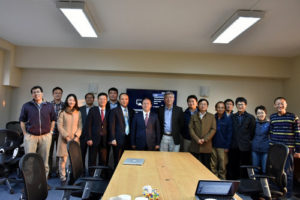Dr. Tieniu Tan, Vice President of Chinese Academy of Sciences (CAS), visited Chile from May 6th to 8th, 2016, as invited by the Chilean Comisión Nacional de Investigación Científica y Tecnológica (CONICYT), the University of Chile and the Chinese Academy of Sciences South America Center for Astronomy (CASSACA). Dr. Xiaoyu Hong (Director General of Shanghai Astronomical Observatories, CAS), Xiaoou Chen (Commissioner of Science and Technology, Chinese Embassy in Chile), Zhong Wang (Director of CASSACA), Wei Wang (Deputy Director of CASSACA) and Dr. Meng Su (MIT) accompanied his visit.
In the morning of May 6th, Dr. Tan met the new CONICYT director Dr. Mario Hummuy and Chilean Senator Dr. Guido Girardi. They discussed potential collaborations between the two countries in astronomy and other aspects of science and technology. Afterwards, Dr. Tan visited the China-Chile Astronomical Data Center (CCADC) and offered his suggestions for its long-term development. CCADC is the first major collaborative project led by CASSACA. Its aim is to enable Chinese and Chilean astronomers to better process astronomical data obtained from large telescopes.
In the afternoon, Dr. Tan visited the Department of Astronomy at the University of Chile. There, he expressed gratitude to director Dr. Guido Garay for the department’s help in the development of CASSACA and discussed future plans for the Center. Dr. Tan then visited the CASSACA office and was introduced to its staff and researchers. Dr. Tan applauded the significant achievements of CASSACA during the past three years, and he encouraged the staff in their efforts to build international scientific cooperation, to drive cutting edge astronomical research, and to develop the Center as a platform for China-Chile collaborations in astronomy and other areas of research. In addition, Dr. Tan met the Chinese Ambassador in Chile, Mr. Baorong Li, and the President of the Chilean Academy of Sciences, Madam Maria Teresa Ruiz, and exchanged ideas with them regarding China-Chile collaborations and CASSACA.
On May 7th and 8th, Vice President Tan went to northern Chile to visit the Atacama Large Millimeter/sub-millimeter Array (ALMA), which is assembled on a 5,060 meter-high plateau, as well as three telescopes dedicated to Cosmic Microwave Background (CMB) research. These were the Atacama Cosmology Telescope (ACT), the Cosmology Large Angular Scale Surveyor (CLASS), and the POLARBEAR telescopes, all of which are assembled on a 5,200 site nearby. Together, these facilities represent the state-of-the-art science and technology in radio astronomy and are the results of a wide-range of international collaborations. Dr. Tan’s visit is among the first that CAS leaders made to the 5,000+ meter sites in Chile.
ALMA is an astronomical interferometer of radio telescopes built collaboratively by several institutions from Europe, the United States and East Asia. It consists of 66 12-meter and 7-meter diameter radio telescopes, observing at millimeter and submillimeter wavelengths, with a resolution of up to 0.01 arcsec. ALMA is expected to be able to provide insights on star birth during the early universe and detailed imaging of local star and planet formation. ALMA is located in the Atacama Desert of Northern Chile, on the Chajnantor plateau. The location is one of the driest sites in the world and very suitable for mm and submm observations. After about 15 years of construction, costing US$1.4 billion, ALMA began full operation in March 2013. The observatory has since attracted close attention from astronomers from all nations and led to various new scientific discoveries.

CAS Vice President Tieniu Tan Visits Chile
